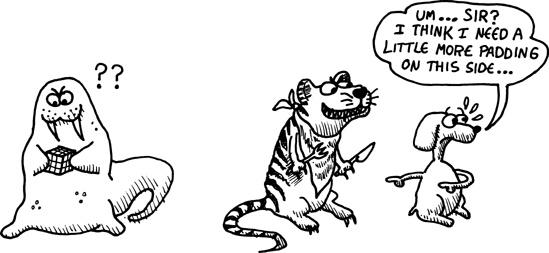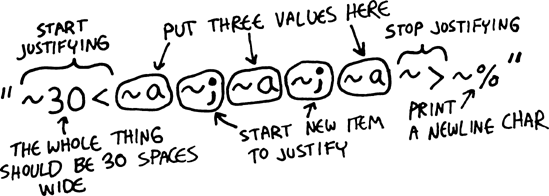The format command also gives us a lot of control over text justification. Control sequences allow us to format tables, center text, and perform other useful justification feats.
To help you understand the various justification rules, we’ll create a simple function that returns different animal names with varying character lengths:
>(defun random-animal ()(nth (random 5) '("dog" "tick" "tiger" "walrus" "kangaroo")))RANDOM-ANIMAL >(random-animal)"walrus"
Now suppose we want to display a bunch of random animals in a table. We can do this by using the ˜t control sequence. ˜t can take a parameter that specifies the column position at which the formatted value should appear. For example, to have our table of animals appear in three columns at the fifth, fifteenth, and twenty-fifth character positions, we could create this table:
>(loop repeat 10do (format t "˜5t˜a ˜15t˜a ˜25t˜a˜%"(random-animal)(random-animal)(random-animal)))kangaroo tick dog dog walrus walrus walrus tiger tiger walrus kangaroo dog kangaroo tiger dog tiger walrus kangaroo tick dog tiger kangaroo tick kangaroo tiger dog walrus kangaroo kangaroo tick
Remember that a loop command with a repeat 10 clause executes the body of the loop 10 times. As you can see, use of the ˜t control sequence caused the animals to be laid out in a neatly formatted table.
Now suppose we want all the animals be spaced equally apart on a single line. To do so, we can use the ˜< and ˜> control sequences, as follows:
>(loop repeat 10do (format t "˜30<˜a˜;˜a˜;˜a˜>˜%"(random-animal)(random-animal)(random-animal)))tick tiger tick tick tiger dog tick dog dog kangaroo kangaroo tiger tiger tiger kangaroo walrus kangaroo dog dog dog walrus kangaroo dog walrus walrus dog walrus kangaroo tiger tick
Let’s deconstruct this control string to understand how it works:
First, the ˜30< tells the function that we’re initiating a block of justified text. The parameter 30 indicates that the block should be 30 characters wide. Next, we have three ˜a control sequences in a row, one for each animal. Each ˜a is separated by ;, which tells format that we’re starting a new value to be justified by ˜<. (The ˜; sequences indicate where extra spaces should be inserted to justify the values.) We then end the justified section with the ˜> command sequence.
Because the equal spacing of the animals in each line doesn’t guarantee that the columns created by printing multiple lines will be properly aligned, we add the :@ flag to our justification ˜< command sequence. For example, we can create a single, neatly centered column as follows:
> (loop repeat 10 do (format t "˜30:@<˜a˜>˜%" (random-animal)))
dog
walrus
kangaroo
tick
tick
tiger
dog
kangaroo
kangaroo
dogIn the same way, we can use :@ with multiple justified values, centering them on the line with additional space at their left and right ends:
>(loop repeat 10do (format t "˜30:@<˜a˜;˜a˜;˜a˜>˜%"(random-animal)(random-animal)(random-animal)))walrus tick tick walrus tiger tick tick dog tick walrus tiger tiger kangaroo dog kangaroo tiger kangaroo walrus tiger kangaroo kangaroo kangaroo tiger tick tick tiger walrus walrus tiger tick
This step brings us closer to having three neatly centered columns, but our columns are still a bit wavy because we’re aligning the values within a single line, without telling format to arrange the values using three centered columns.
To produce neat columns, we’ll still use the :@ flag, but we’ll describe our rows using three separate 10-character justification sections:
>(loop repeat 10do (format t "˜10:@<˜a˜>˜10:@<˜a˜>˜10:@<˜a˜>˜%"(random-animal)(random-animal)(random-animal)))tiger kangaroo kangaroo kangaroo kangaroo walrus tick tick tick dog dog dog tiger dog walrus dog tiger kangaroo walrus dog tick tick walrus kangaroo dog tick walrus tiger tiger tiger
At last, we have the nicely centered random animal columns of our dreams!
As you can see, the layout options for format are quite flexible. Since we often need to create complex lists and tables of data when debugging applications, these tricks are very helpful when you need to get a handle on your data, even with more complex programs.


